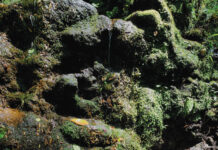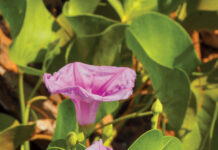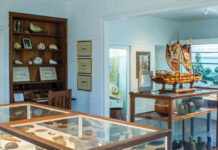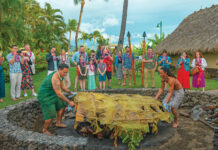Jill Engledow | Photo by Nina Lee
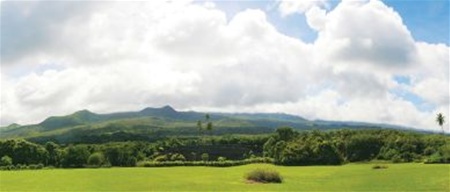 Twenty years ago, if you’d hiked along the Hana Coast, you might have stumbled upon a mysterious ruin hidden in the dense jungle, an enormous structure cloaked by a wall of greenery. The biggest heiau in the Pacific (and therefore the world, since heiau are uniquely Polynesian), Pi‘ilanihale Heiau today looms black against the distant blue silhouette of Haleakala, its cliff-like walls topped by a cluster of graceful coconut palms.
Twenty years ago, if you’d hiked along the Hana Coast, you might have stumbled upon a mysterious ruin hidden in the dense jungle, an enormous structure cloaked by a wall of greenery. The biggest heiau in the Pacific (and therefore the world, since heiau are uniquely Polynesian), Pi‘ilanihale Heiau today looms black against the distant blue silhouette of Haleakala, its cliff-like walls topped by a cluster of graceful coconut palms.
The heiau is kapu—forbidden, sacred—and visitors are not allowed to climb onto it or disturb its stones. But an easy path through lovely Kahanu Garden allows anyone to stand awestruck before this archaeological treasure, the largest remaining ancient structure in Hawai‘i.
Built in four phases, Pi‘ilanihale Heiau is named for Pi‘ilani, the great sixteenth-century ali‘i who brought about an era of peace and prosperity as the first ruling chief to unite Maui. The oldest parts of this massive structure date back even further—probably to the 1200s. Its thousands and thousands of carefully stacked stones were carried by hand from as far as Hana Bay, seven miles away.
Over the centuries, jungle engulfed the great heiau, and time tumbled its stones. Generations managed the care of this relic by benign neglect, at least partly because of old attitudes that made people shy away from ancient sites. Even today, little is known about the history of the heiau, why it was built, exactly when, or what it was used for.
But with renewed interest in pre-Contact Hawai‘i and its culture, people wanted to see the heiau. In 1999, Hana families who still specialize in old-style construction lashed together their own ladders, found the “tooth stones” set to stand vertically at intervals along the foundations of tumbled walls, and began to rebuild around them.
In only nine months, they had cleared the jungle and restored crumbled edges. Pi‘ilanihale Heiau once more dominated the landscape.
A sacred temple was not exactly what the National Tropical Botanical Garden had in mind when it acquired this property back in 1974. Then a relatively new nonprofit organization, NTBG had been chartered by Congress to discover, save and study the world’s tropical plants and to share what it learned.
But here in Hana, it seems more than right that this ancient religious site should be restored and maintained, overlooking a garden whose mission is to perpetuate the use of the plants that nourished those who carried and stacked its stones.
One of five gardens that make up the National Tropical Botanical Garden, Kahanu Garden was named for Chief Kahanu, who was granted half of the ahupua‘a Honoma‘ele during the Mahele, the great land division of 1848.
Here in Honoma‘ele, you can almost feel the spirits of ka poe kahiko—the people of old. Their plants flourish on this wet, green Hana coastline, useful growing things that made life possible on islands in the middle of the sea.
Ka‘eleku Plantation grew sugar here for a century. After the plantation closed in 1946, Hana Ranch turned the cane fields into pasture.
In 1974, the ranch and descendants of Chief Kahanu deeded 61 acres to NTBG in exchange for its promise to restore the heiau, share it with the public, and provide perpetual care for it and for the family graves on the land. Since then the garden has grown, with an anonymous donor purchasing an adjoining 62 acres in 1974 and an additional purchase in 2002, bringing the total to 294 acres.
The first thing visitors see as they enter the garden is an enormous grove of breadfruit trees.
“We’re going for ‘ulu world domination,” the garden’s executive director, Kamaui Aiona, likes to joke. “As far as we know, we’re the largest collection in the world,” with almost 300 trees of assorted varieties.
While the large, handsome Hawaiian breadfruit tree is well-known in the Islands, this garden includes hybrids and relatives from around the Pacific whose fruit, leaves and habits vary.
Some leaves have the usual deep lobes, while others’ edges are barely indented. Fruit can grow as big as twelve pounds. One variety, the breadnut, contains edible seeds.
In addition to its scientific value and the potential for fighting hunger in poor tropical areas, this collection is also a community resource, Aiona says. “We have a lot of breadfruit on our hands,” and while the garden sells some, it also gives a lot to the neighbors.
“One of the best things about this garden is the community tie-in,” Aiona says. “People are coming back to the land and want to know what to grow. We’re here to perpetuate and preserve, but in a setting where we get to share the knowledge with everybody. [Kahanu Garden] is not just a museum.”
Visitors receive a brochure that includes a self-guided tour with photos and information about plants in the Canoe Garden. Carried to Hawai‘i by Polynesian settlers in voyaging canoes nearly 2,000 years ago, these plants were the most important resources in Polynesian culture, providing the raw materials for food, shelter, clothing, medicine, ceremony and recreation.
The garden clearing descends to an astoundingly beautiful coastline where white waves rise from a deep blue ocean to break against black lava cliffs. Most of the garden is manicured, except for coconut palms allowed to maintain their natural growth pattern and therefore likely to send ripe coconuts or dried fronds crashing to the ground. Visitors are warned to stay out of range.
For everything else, it’s possible to get up close, to observe the many colors of sugarcane stalks, the stripes in a variegated banana, the new purple leaves in a bed of sweet potatoes, a fluorescent yellow sap in the seed of a milo tree.
Following the path of the self-guided tour leads directly to the steep walls of the heiau. Its size and magnificence are proof that long ago a society thrived here with the population and the resources to build such a structure. Today the enormous walls overlook a garden where once again the people of Honoma‘ele cultivate the plants of their ancestors.

